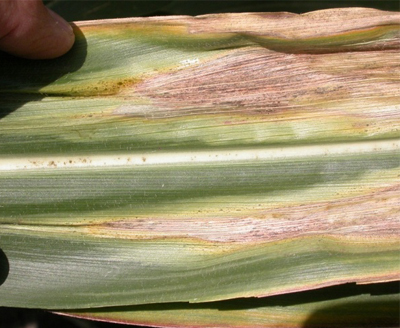
- Goss’s wilt is a bacterial disease of corn first discovered in Nebraska in 1969.
- This disease is most common in Nebraska and surrounding states, but it has shown up in other areas, including east of the Mississippi River.
- Goss’s wilt infection is usually associated with storms, windblown soil, or mechanical injury but seedborne transmission has been documented.
- Corn hybrids vary greatly in their susceptibility to Goss’s bacterial wilt.
Introduction:
Goss’s wilt in corn is a bacterial disease that was first discovered in Dawson County, Nebraska in 1969. The disease is still primarily found in Nebraska and surrounding states but has shown up east of the Mississippi River when conditions have been favorable. Under the right conditions, storms are capable of transporting live bacteria over long distances. While Goss’s wilt is not common outside of its core geography, it can cause significant injury to corn where it shows up. Yield losses of up to about 50% have been reported.
Disease Transmission / Infection:
Infection of corn by Goss’s wilt is often associated with storms. Heavy rain can splash bacteria onto the corn plant or bacteria can even become suspended in storm fronts. Leaf damage from hail, windblown soil, or mechanical damage appears to encourage infection. Bacteria are able to invade corn tissue through natural openings, like leaf stomata. Overhead irrigation may also encourage Goss’s wilt infection.
Seed transmission of Goss’s wilt has been documented. However, this does not seem to be a common source of the disease.
Disease Profile and Description:
Goss’s wilt is caused by the bacterium Clavibacter michiganensis subspecies nebraskensis. Infection can occur at any time of the growing season, although symptoms most commonly appear after pollination. On corn leaves, Goss’s wilt causes elongate lesions that have a grayish, water-soaked appearance and wavy margins. These lesions can easily be confused with those caused by Stewart’s bacterial wilt but the flea beetle feeding marks are absent. The lesions are also easy to confuse with northern corn leaf blight or with leaf scorch. In susceptible corn hybrids, Goss’s wilt may blight upper leaves of corn either within patches or within large areas of fields.
Lesions caused by Goss’s wilt usually develop dark spots within the lesion, giving this disease its alternate name of Nebraska leaf freckles. The dark spots are often most noticeable at the edges of the lesions. These dark spots are embedded within the leaf tissue and cannot be rubbed off. Leaf lesions may also develop a shiny appearance as bacterial exudate seeps onto the leaf surface in lesions.
When stalk infection occurs, a brownish-orange vascular discoloration or rot occurs in the lower part of the stalk with streaks progressing upward in vascular bundles. An orange bacterial exudate may be seen coming from infected vascular tissue. Early stalk infection is responsible for the wilt phase of this disease.
A bacterial “ooze test” is sometimes used to help confirm Goss’s wilt.Goss’s wilt lesions do not always cooperate, though, so absence of bacterial oozing does not always eliminate this disease.There are a couple “quick tests” that have been used to verify Goss’s wilt.Unfortunately, experience has shown that at least one of these tests will sometimes give false positive results for the disease, especially where saprophytic mold growth is present.
Managing Goss’s Wilt in Corn:
Corn hybrids vary considerably in resistance to Goss’s wilt. Most hybrids have some level of resistance. Where Goss’s wilt is established as a chronic disease of corn, hybrids should be selected that have shown good resistance to the disease.
Corn residue may serve as the source of infectious bacteria. Where Goss’s wilt has shown up, and where it is feasible, inoculum levels should be reduced by destroying corn residue with tillage. Note that this will not stop bacteria from entering from neighboring fields. Crop rotation should be practiced and growing corn-after-corn should be avoided where possible.
Goss’s wilt can survive on a number of grass weeds, like barnyardgrass, green foxtail, and shattercane. Weed control can be helpful in reducing inoculum levels.
Growers have experimented with spray application of bactericides and citric acid to arrest development of Goss’s wilt, but these have met with limited success.

Image 1: Goss's Wilt
Image 2: Goss’s Wilt Classic Symptoms
Image 3: Goss’s Wilt Vascular Discoloration of Stalk
Image 4: Northern Corn Leaf Blight
Image 5: Leaf Scorch with Saprophytic Mold Growth